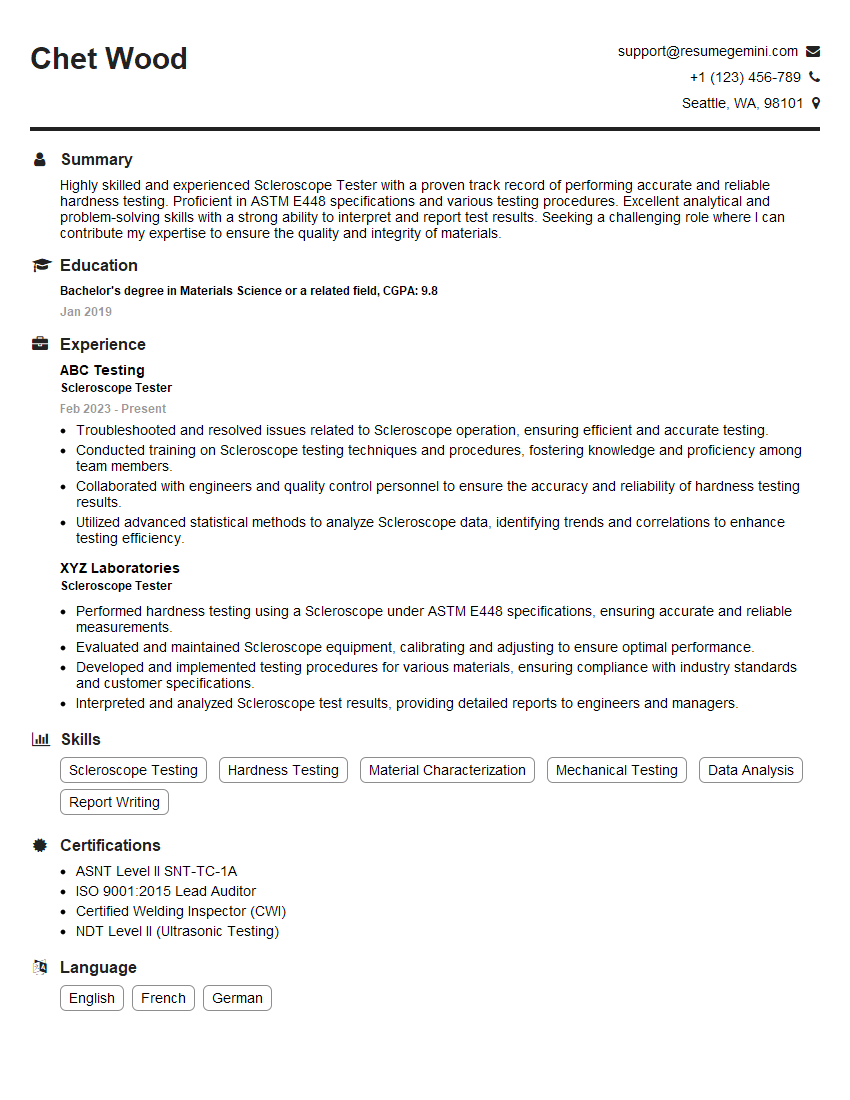Are you a seasoned Scleroscope Tester seeking a new career path? Discover our professionally built Scleroscope Tester Resume Template. This time-saving tool provides a solid foundation for your job search. Simply click “Edit Resume” to customize it with your unique experiences and achievements. Customize fonts and colors to match your personal style and increase your chances of landing your dream job. Explore more Resume Templates for additional options.

Chet Wood
Scleroscope Tester
Summary
Highly skilled and experienced Scleroscope Tester with a proven track record of performing accurate and reliable hardness testing. Proficient in ASTM E448 specifications and various testing procedures. Excellent analytical and problem-solving skills with a strong ability to interpret and report test results. Seeking a challenging role where I can contribute my expertise to ensure the quality and integrity of materials.
Education
Bachelor’s degree in Materials Science or a related field
January 2019
Skills
- Scleroscope Testing
- Hardness Testing
- Material Characterization
- Mechanical Testing
- Data Analysis
- Report Writing
Work Experience
Scleroscope Tester
- Troubleshooted and resolved issues related to Scleroscope operation, ensuring efficient and accurate testing.
- Conducted training on Scleroscope testing techniques and procedures, fostering knowledge and proficiency among team members.
- Collaborated with engineers and quality control personnel to ensure the accuracy and reliability of hardness testing results.
- Utilized advanced statistical methods to analyze Scleroscope data, identifying trends and correlations to enhance testing efficiency.
Scleroscope Tester
- Performed hardness testing using a Scleroscope under ASTM E448 specifications, ensuring accurate and reliable measurements.
- Evaluated and maintained Scleroscope equipment, calibrating and adjusting to ensure optimal performance.
- Developed and implemented testing procedures for various materials, ensuring compliance with industry standards and customer specifications.
- Interpreted and analyzed Scleroscope test results, providing detailed reports to engineers and managers.
Certificates
- ASNT Level II SNT-TC-1A
- ISO 9001:2015 Lead Auditor
- Certified Welding Inspector (CWI)
- NDT Level II (Ultrasonic Testing)
Languages
- English
- French
- German
Career Expert Tips:
- Select the ideal resume template to showcase your professional experience effectively.
- Master the art of resume writing to highlight your unique qualifications and achievements.
- Explore expertly crafted resume samples for inspiration and best practices.
- Build your best resume for free this new year with ResumeGemini. Enjoy exclusive discounts on ATS optimized resume templates.
How To Write Resume For Scleroscope Tester
- Highlight your expertise in Scleroscope testing and ASTM E448 specifications.
- Quantify your accomplishments with specific metrics and results whenever possible.
- Showcase your analytical and problem-solving skills by providing examples of how you have resolved complex testing issues.
- Emphasize your ability to work independently and as part of a team, and your commitment to quality and accuracy.
Essential Experience Highlights for a Strong Scleroscope Tester Resume
- Performed Scleroscope hardness testing under ASTM E448 specifications, ensuring accurate and reliable measurements.
- Evaluated and maintained Scleroscope equipment, calibrating and adjusting to ensure optimal performance.
- Developed and implemented testing procedures for various materials, ensuring compliance with industry standards and customer specifications.
- Interpreted and analyzed Scleroscope test results, providing detailed reports to engineers and managers.
- Troubleshooted and resolved issues related to Scleroscope operation, ensuring efficient and accurate testing.
- Conducted training on Scleroscope testing techniques and procedures, fostering knowledge and proficiency among team members.
- Collaborated with engineers and quality control personnel to ensure the accuracy and reliability of hardness testing results.
Frequently Asked Questions (FAQ’s) For Scleroscope Tester
What is the purpose of Scleroscope hardness testing?
Scleroscope hardness testing is a non-destructive method used to determine the surface hardness of materials. It is commonly employed in various industries to assess the mechanical properties and durability of materials.
What are the advantages of using a Scleroscope for hardness testing?
Scleroscope testing offers several advantages, including its portability, simplicity of operation, and ability to provide accurate and reliable measurements on a wide range of materials.
What are the limitations of Scleroscope hardness testing?
While Scleroscope testing is a valuable tool, it has certain limitations. It is primarily suitable for testing the surface hardness of materials and may not be appropriate for materials with non-uniform hardness or complex geometries.
What industries commonly use Scleroscope hardness testing?
Scleroscope hardness testing finds application in various industries, including automotive, aerospace, manufacturing, and materials research. It is particularly useful for testing the hardness of metals, plastics, and ceramics.
What is the role of a Scleroscope Tester?
A Scleroscope Tester is responsible for performing hardness testing using a Scleroscope, ensuring accurate and reliable measurements. They evaluate and maintain Scleroscope equipment, develop and implement testing procedures, and interpret and analyze test results.
What skills are required to become a Scleroscope Tester?
To become a Scleroscope Tester, individuals typically possess a Bachelor’s degree in Materials Science or a related field. They have a strong understanding of Scleroscope testing techniques and ASTM E448 specifications, as well as excellent analytical and problem-solving skills.
What are the career prospects for Scleroscope Testers?
Scleroscope Testers can advance their careers by specializing in specific industries or materials testing applications. They may also pursue managerial roles or become involved in research and development within the field of materials science.